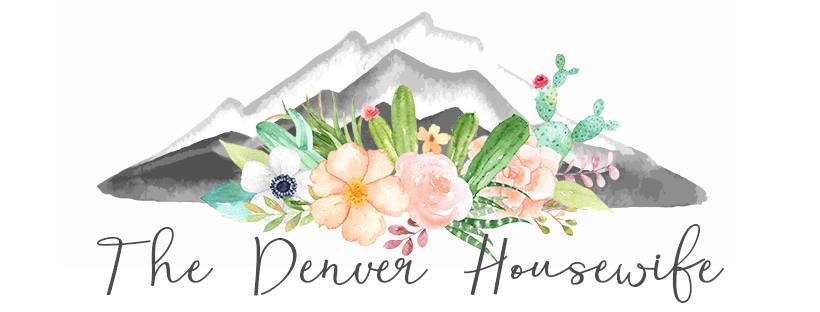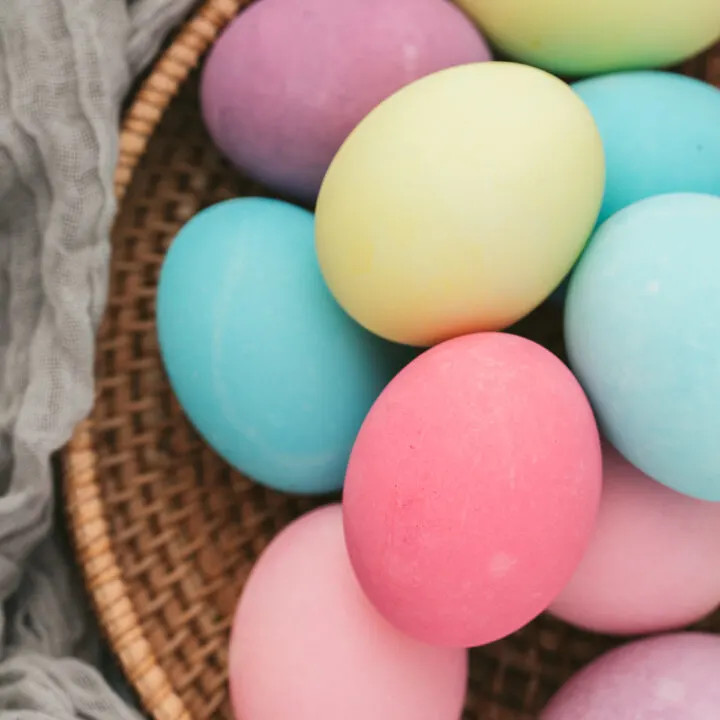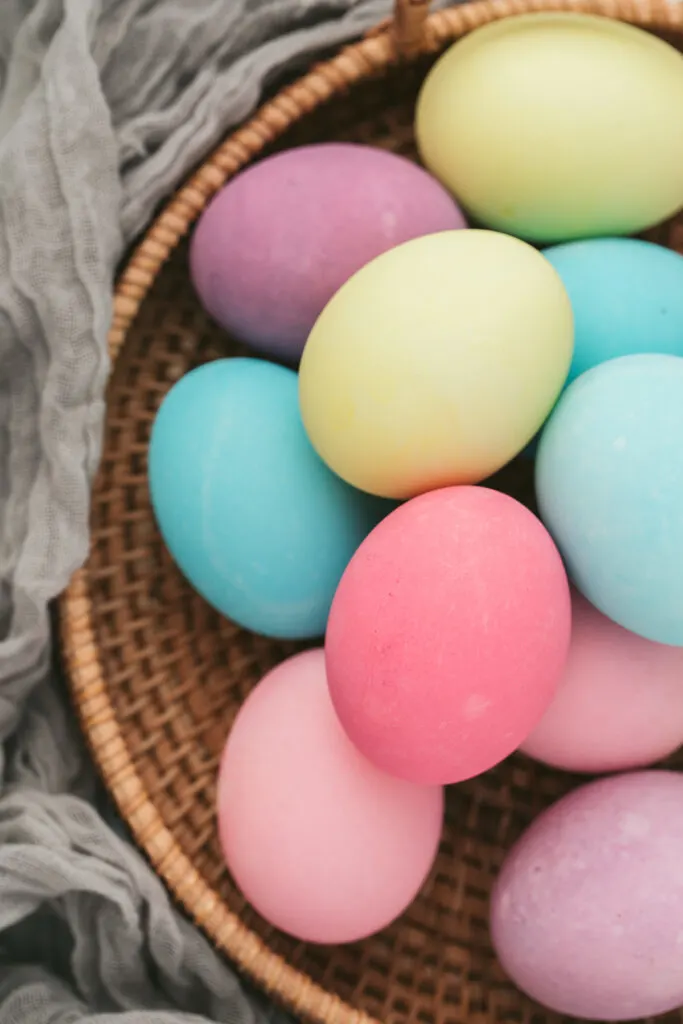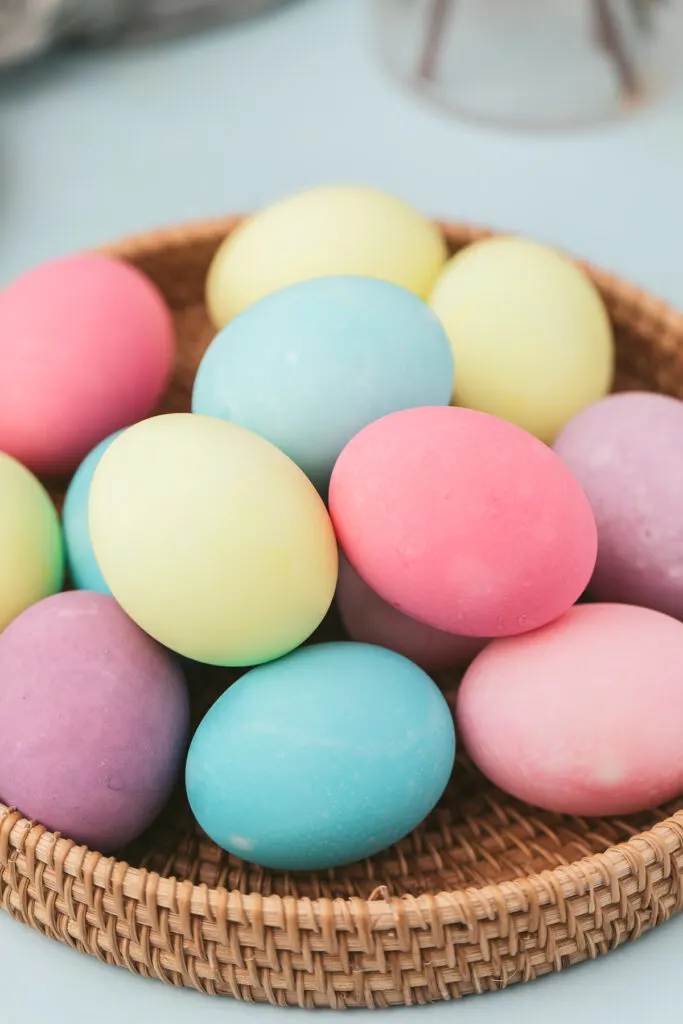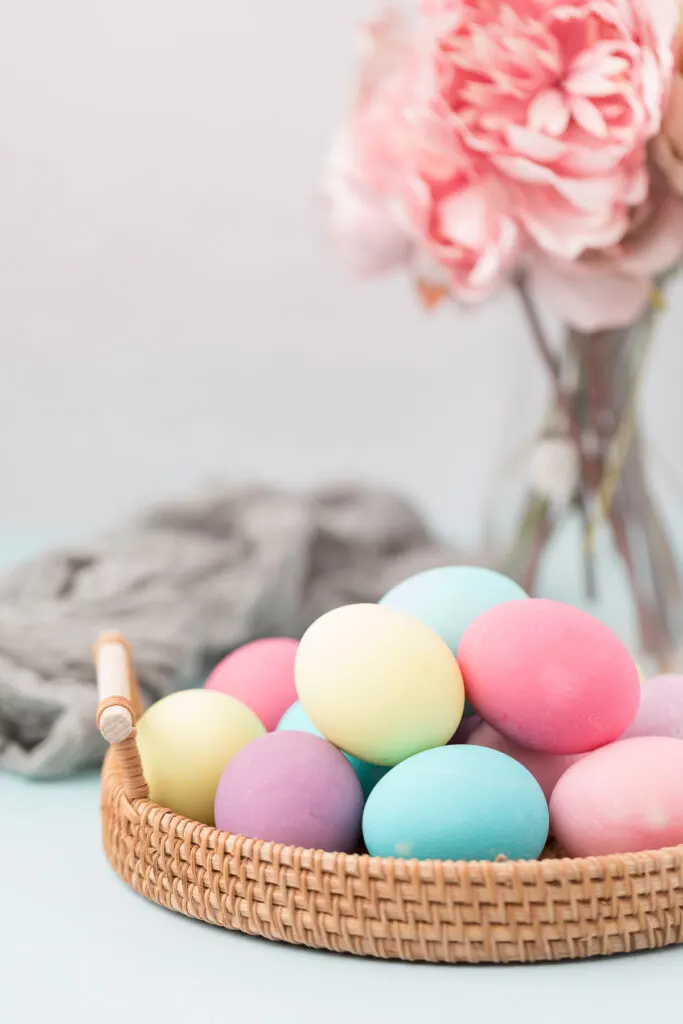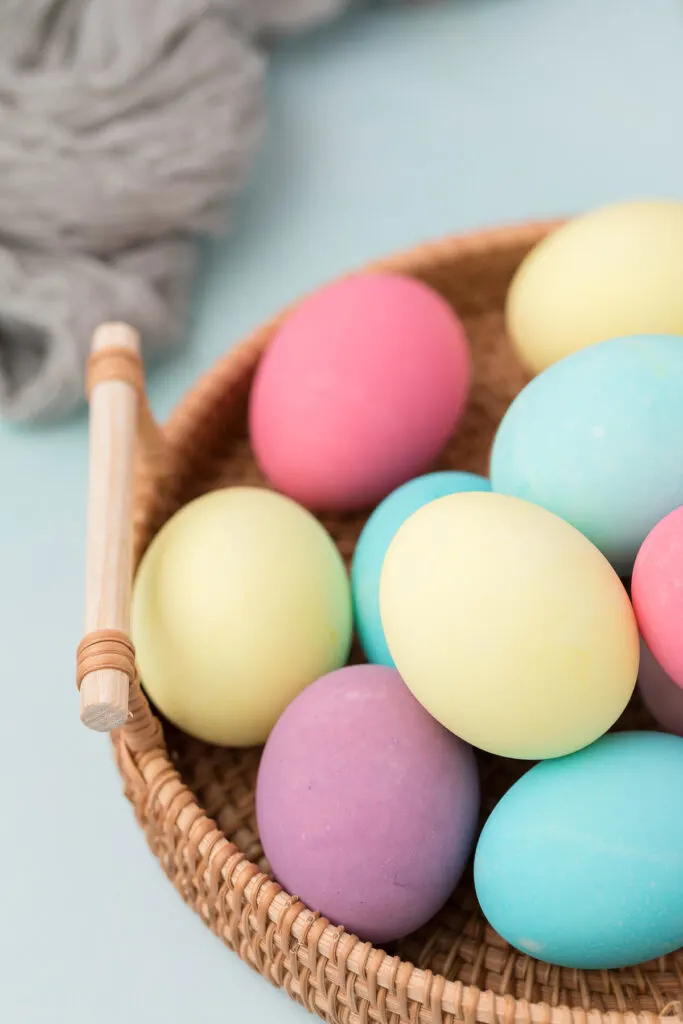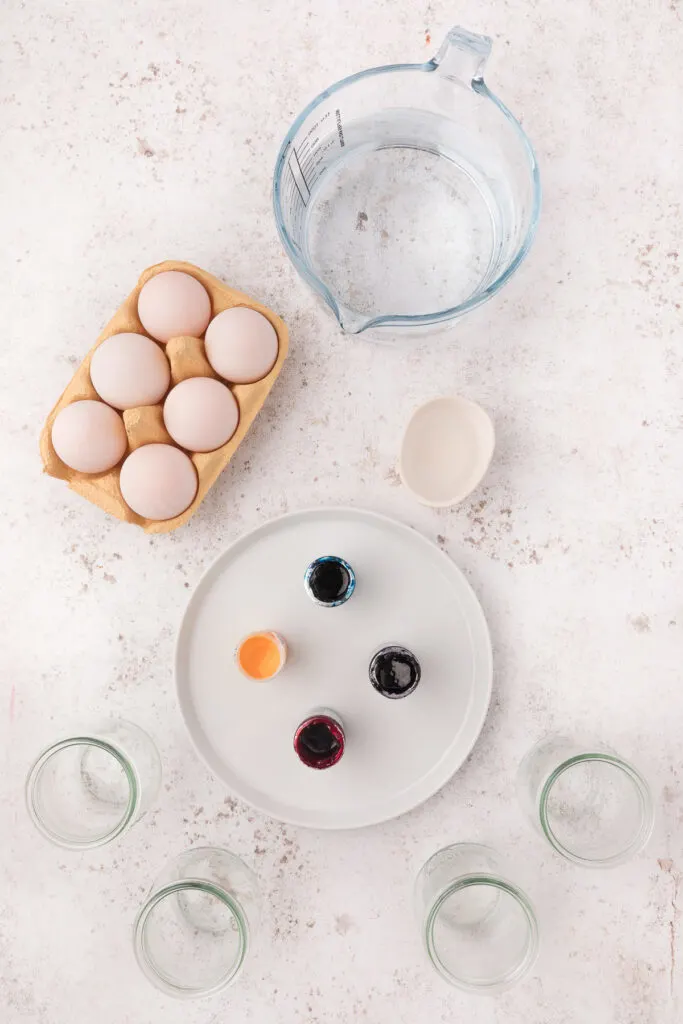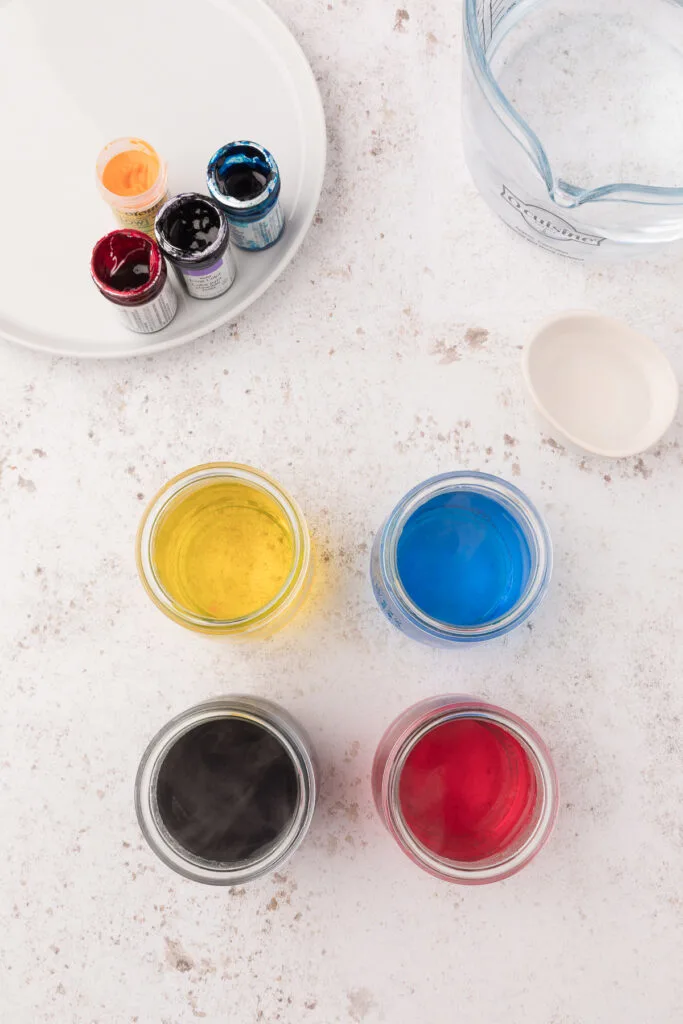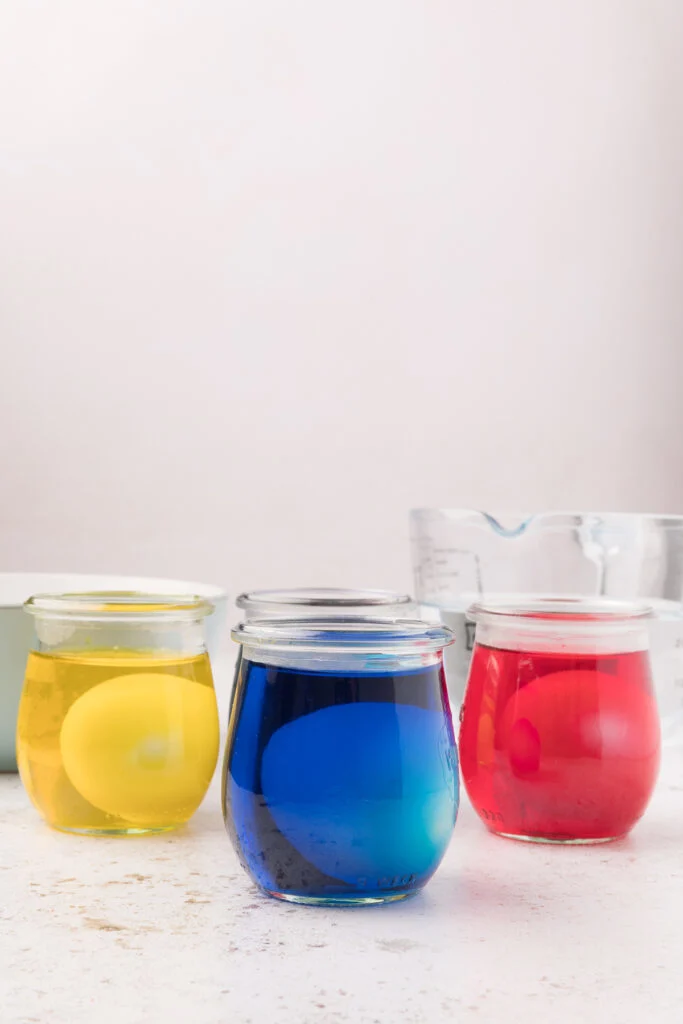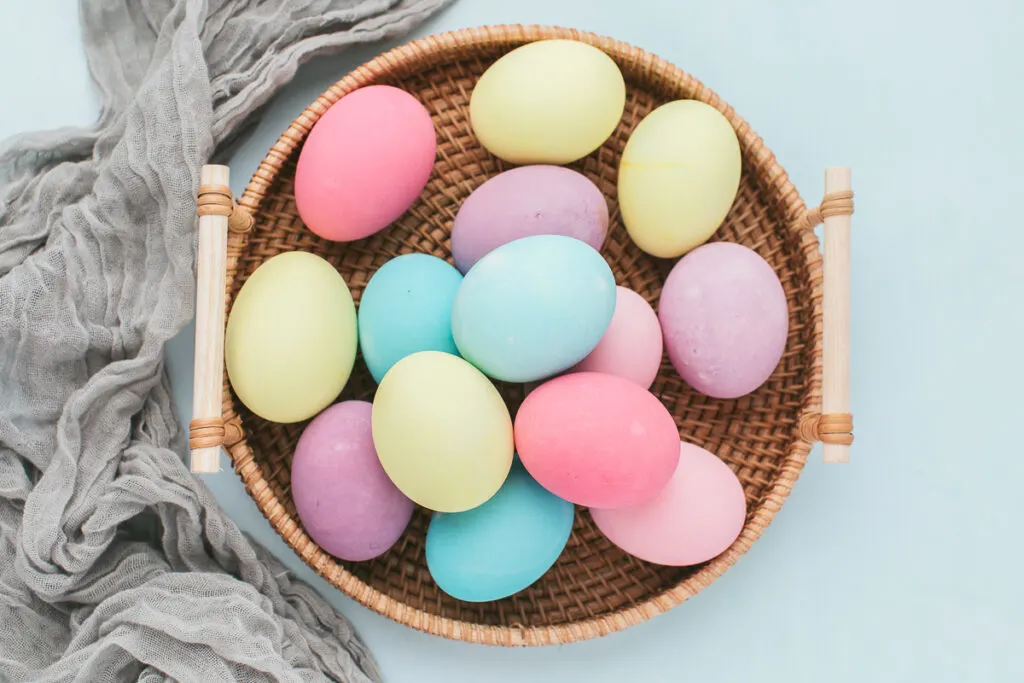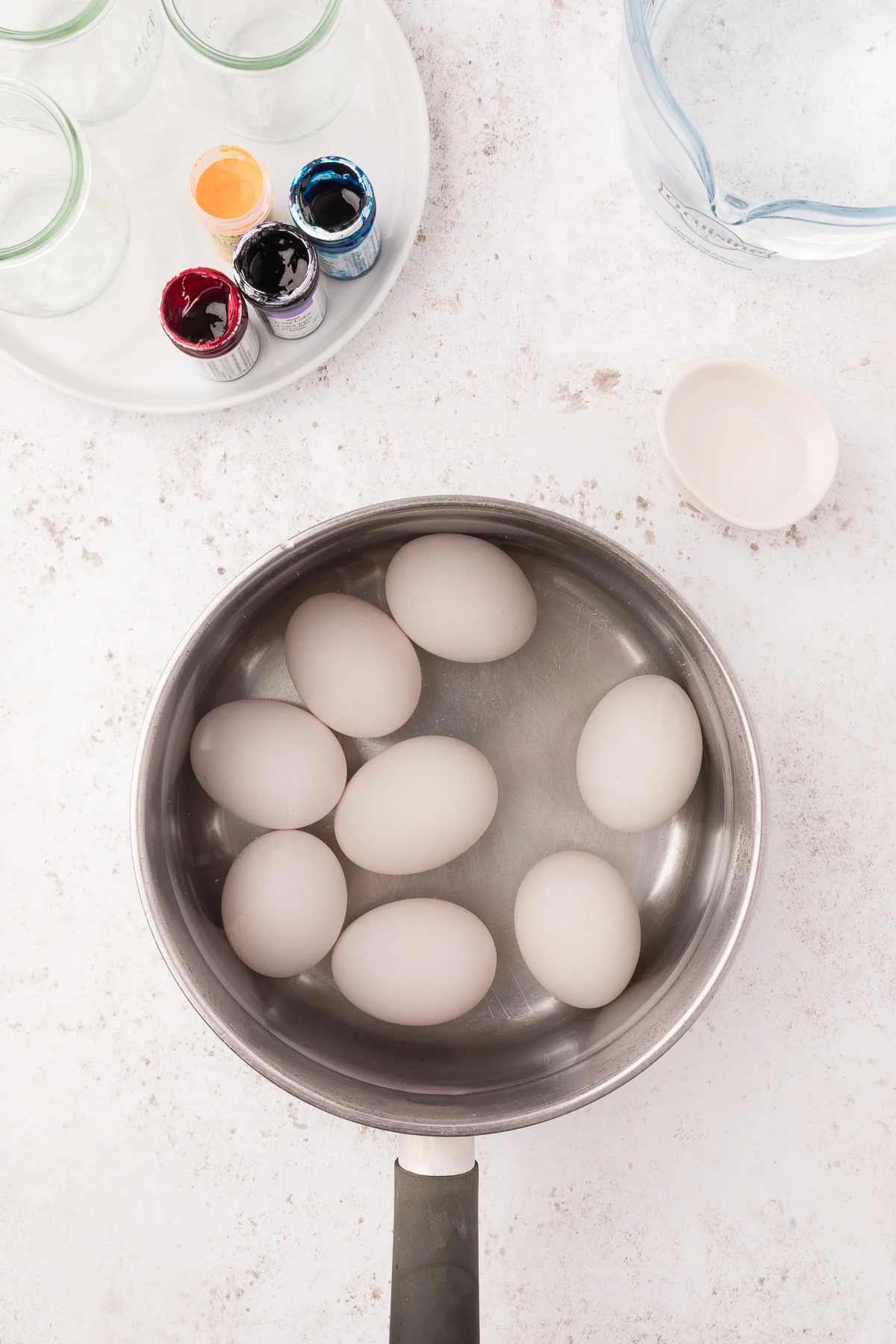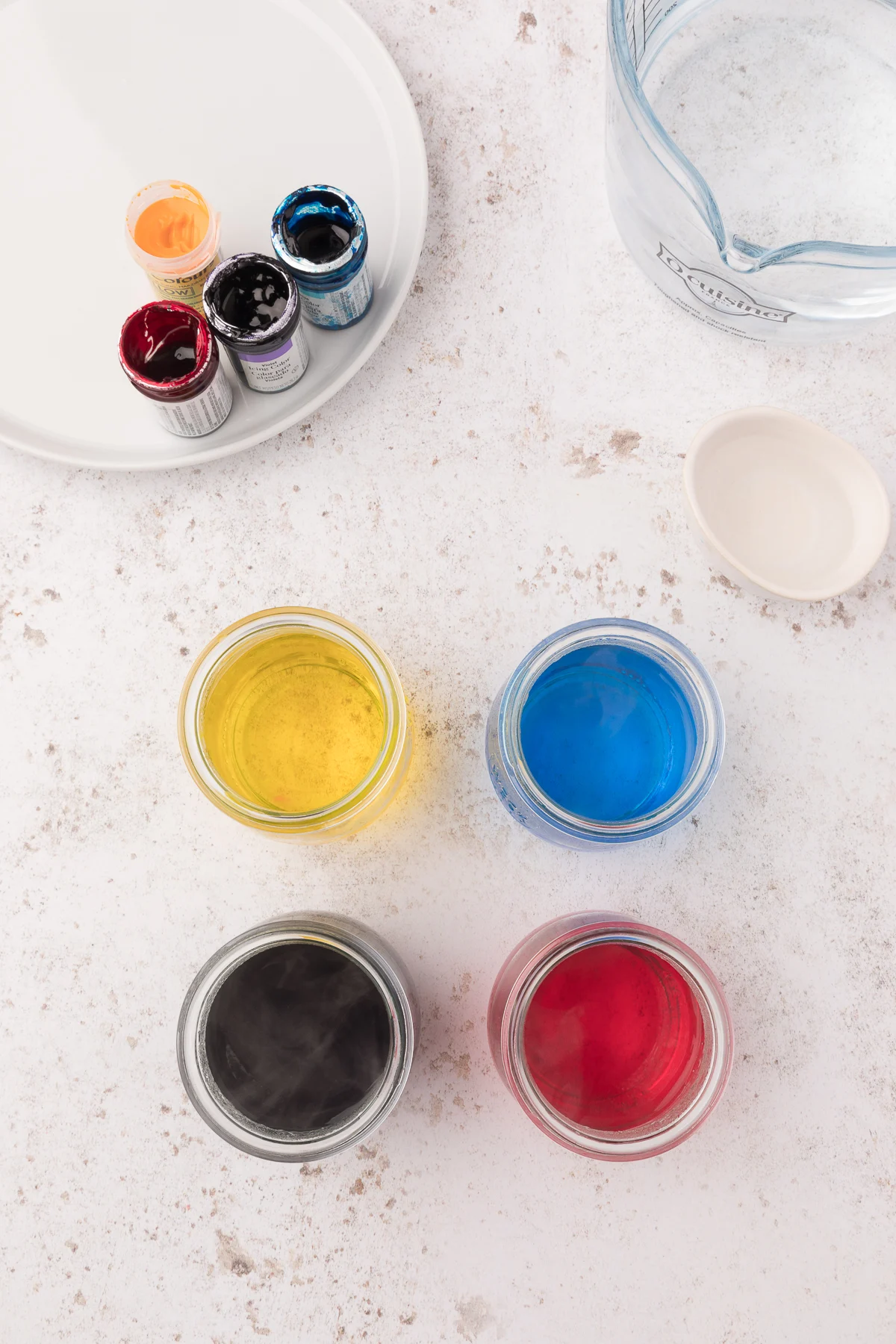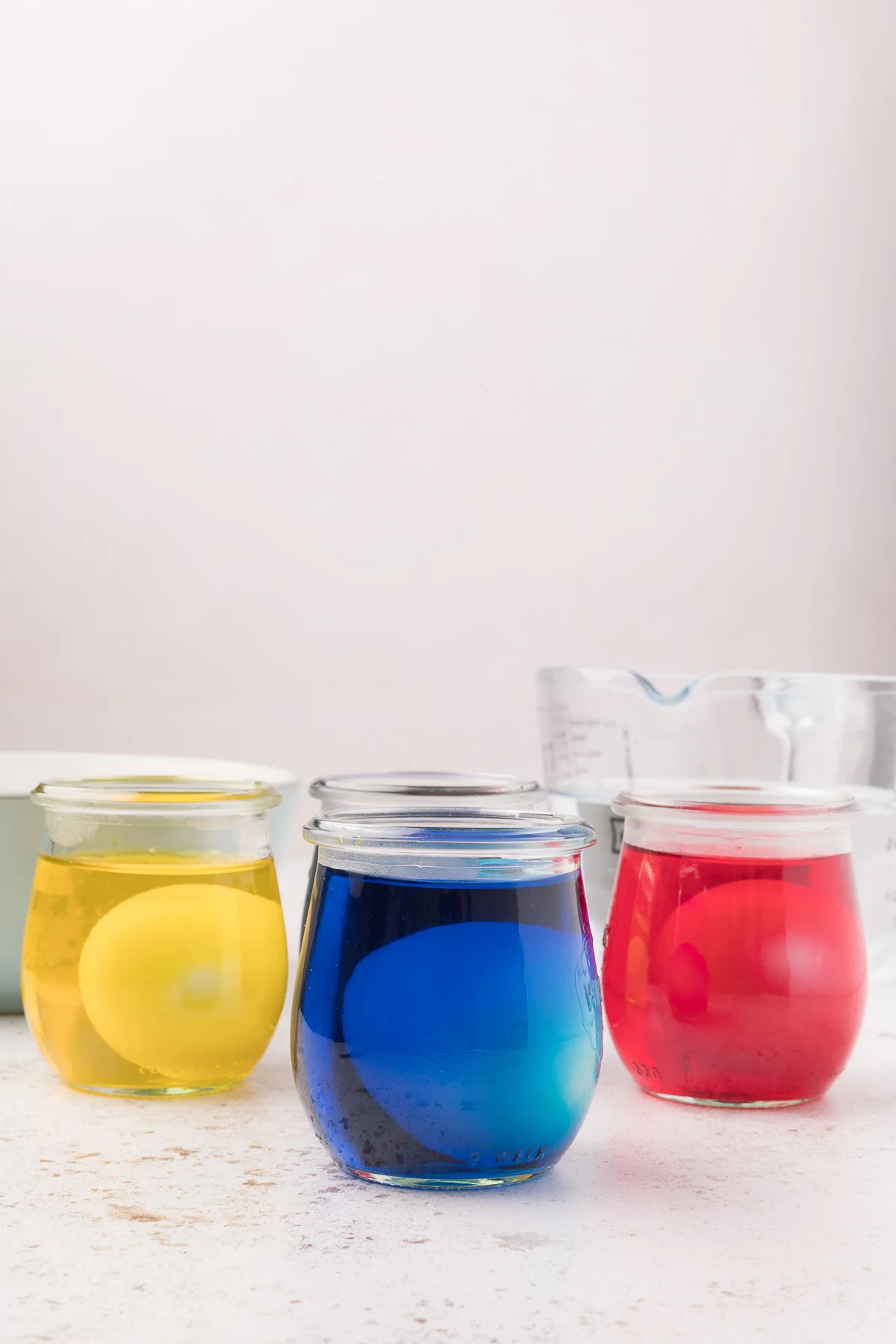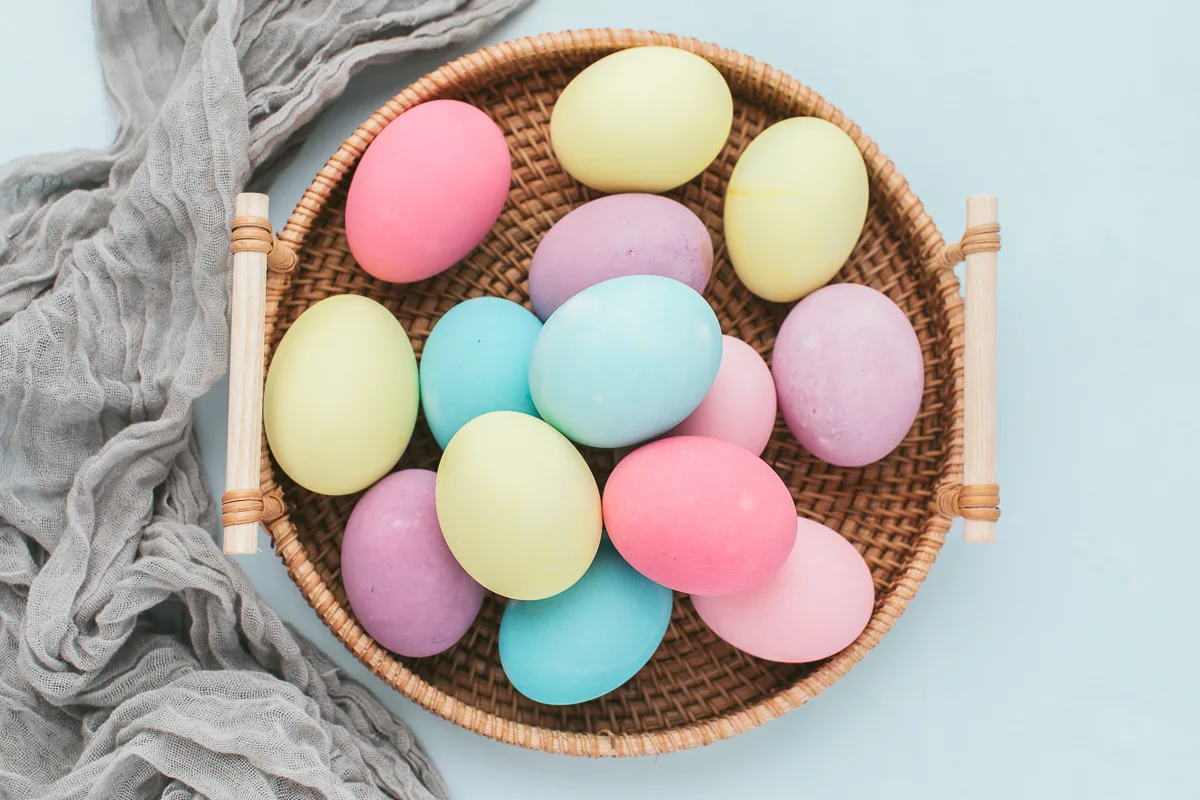Want to dye eggs with food coloring, but you don’t have an egg dying kit? Chances are you have food coloring and vinegar in your pantry and you can dye hardboiled eggs with just those 2 things (plus water). Easily color eggs with food coloring and vinegar at home with these easy steps!
Dying eggs with food coloring is an easy and simple process that uses water, food coloring, and vinegar to color your Easter eggs. You can hard-boil your eggs any way you see fit, but I share my process below. Come learn how to make homemade egg dye for Easter eggs.
How to Dye Eggs with Food Coloring
Dying easter eggs with food coloring is simple and easy. You can get pretty pastel-colored Easter eggs or bright vibrant Easter eggs with food coloring depending on how much food coloring you add to your water. For more pastel-colored eggs you’ll use less dye and for more vibrant colored eggs you’ll add more food coloring.
What Food Coloring to Use to Dye Eggs
You can use either liquid food coloring or gel food coloring. I find gel food coloring is more readily available these days, but use whatever you have on have or you can find at your local store. I am using gel food coloring since it’s what I have on hand.
I use the Wilton Gel Food Coloring for food coloring easter eggs, but any brand of food coloring will work.
How to Hard Boil Easter Eggs
One of my favorite ways to boil eggs for dyeing is with my Air Fryer (full tutorial) or Instant Pot. I’ll even share steps below on how to hard boil eggs on the stove.
How to Store Hard Boiled Easter Eggs
You can store easter eggs in the fridge for 3-5 days.
Dying Easter Eggs with Food Coloring
I hate the Easter egg kits at the store. I always feel like the little tablets never dissolve right, so we’re going to make our own homemade Easter Egg dye kit. It’s cheaper, easier, and chances are you have the items needed in your pantry. I’ll show you how to dye Easter eggs without a kit in step-by-step instructions. Are you ready to make coloring easter eggs with food coloring?
Tips for Dying Easter Eggs
- Adding a pinch of salt and a splash of white vinegar once the water has reached boiling point will prevent your eggs from cracking. You will end up with perfectly set hardboiled eggs with their shells completely in tact.
- We used gel food colouring in pink, purple, yellow and blue. Liquid food coloring also works well and you can use any colors you like!
- We found that the yellow color took the best followed by the pink.
- There can be experimenting involved to make the eggs the colors that you like. This makes this a great activity to do with children.
- The eggs are still edible afterwards and the dye doesn’t transfer through the shells.
- Mix food coloring colors to get even more color options.
- Get creative with your Easter Egg dying by tying rubber bands or twine around the eggs to give them a marbled look. Decorate the eggs with stickers or markers for extra designs.
Do you Have to Use Vinegar to dye eggs?
While Vinegar is best to use when dying eggs you can substitute vinegar with lemon juice. The acid in the vinegar helps to dye the eggs and give them their vibrant colors. Since lemon juice also is an acid you can use it instead (similar to when making homemade buttermilk). You can skip the vinegar and lemon juice and just use water and food coloring, but the colors will be very light.
Do Eggs have to be Warm or Cold to Dye?
You can use warm eggs, but they might be too hot/warm for little hands to handle. I like to let my eggs cool off before dying so they’re easier to handle. To cool eggs off quicker you can place them in an ice bath for hard-boiled eggs. Learn how to do an ice bath here.
How to Dye Easter Eggs
Let’s get started on our food coloring easter eggs. You are going to need:
- Water
- Vinegar
- Food Coloring
- Hard Boiled, White Shell Eggs
- Class cups or jars
- Paper Towels
- Tongs
How to Dye Easter Eggs with Food Coloring
How to Hard Boil Eggs on the Stove
Add eggs to a saucepan and then fill the saucepan with water, making sure the eggs are covered in water.
Put the saucepan on the stove and then bring it to a boil. When the water is boiling add the
salt and a splash of white vinegar. Turn off the heat and put a lid on the pan. Set a timer for 12
minutes.
When the 12 minutes is up remove the eggs from the water and place them in an ice bath for a few minutes to cool the eggs down.
How to Color Easter Eggs with Gel Food Coloring
Fill your glass jars halfway with boiling water and add 2 teaspoons of
white vinegar.
Next, add the food coloring. How much you add is up to you! For a deeper, more intense color
add more and for a lighter pastel shade add less. You can experiment as you go and switch
out the water/food coloring to get the desired shade. If using liquid food coloring add about 10 drops and if using gel start with about 5 drops.
Add the hard-boiled eggs to the jars (you will probably need to do one at a time unless you have a very large jar) and leave them for 5 minutes to absorb the color. Eggs will need to be completely submerged under the water. Keep an eye on the eggs and remove them from the jars when they have reached a color that you are happy with.
Remove the eggs from the jars using tongs.
Put the dyed eggs on some kitchen paper to dry.
Repeat the dyeing process for all the hardboiled eggs.
Store in the fridge until ready to enjoy!
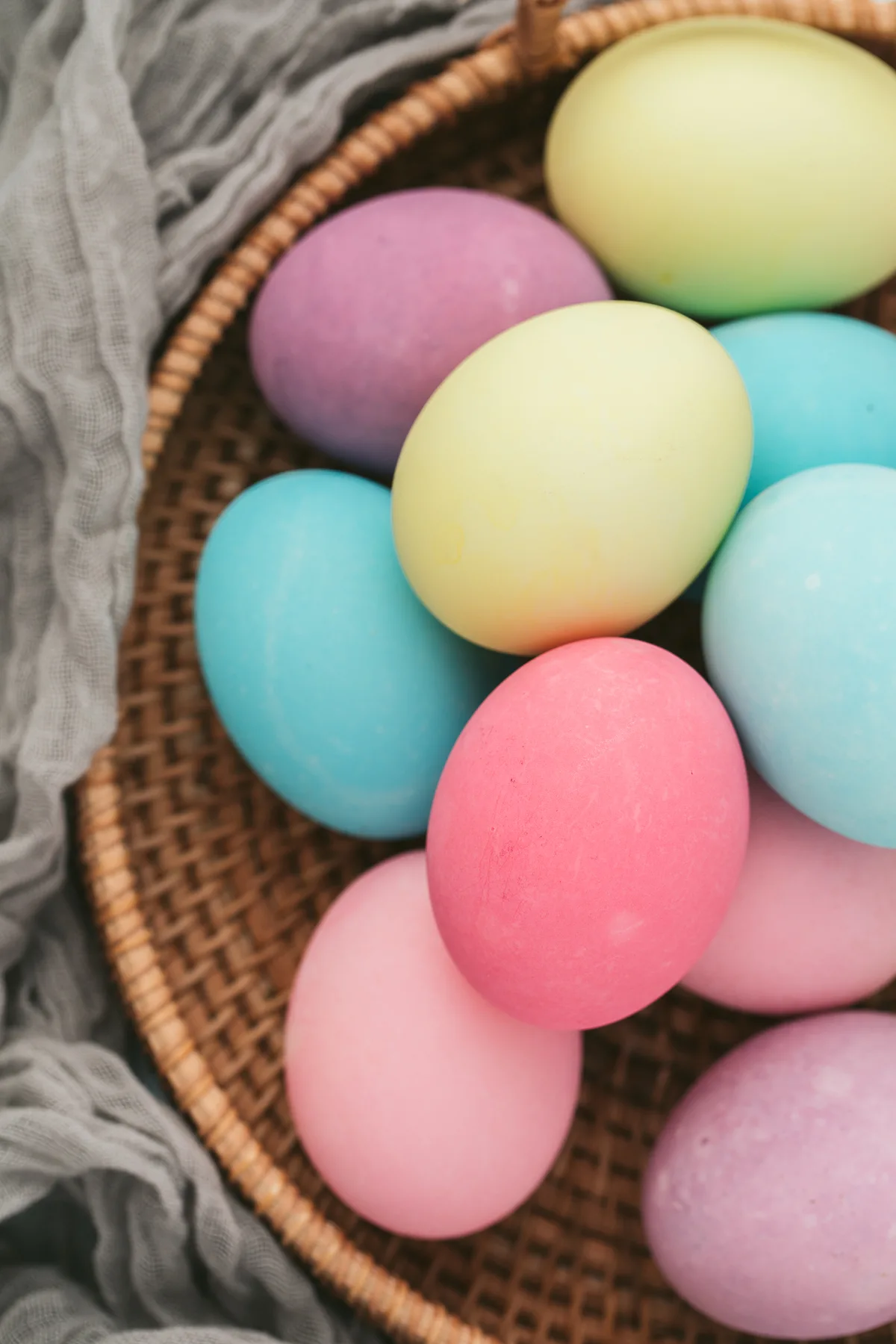
How to Dye Easter Eggs with Food Coloring
An easy way to dye easter eggs with food coloring using just 3 ingredients.
Materials
- Water
- Vinegar
- Food Coloring
- Hard Boiled, White Shell Eggs
Tools
- Class cups or jars
- Paper Towels
- Tongs
Instructions
- Fill your glass jars halfway with boiling water and add 2 teaspoons of white vinegar.
- Next, add the food coloring. How much you add is up to you! For a deeper more intense color and more and for a lighter pastel shade add less. You can experiment as you go and switch out the water/food coloring to get the desired shade. If using liquid food coloring add about 10 drops and if using gel start with about 5 drops.
- Add the hard-boiled eggs to the jars (you will probably need to do one at a time unless you have a very large jar) and leave them for 5 minutes to absorb the color. Eggs will need to be completely submerged under the water. Keep an eye on the eggs and remove them from the jars when they have reached a color that you are happy with.
- Remove the eggs from the jars using tongs.
- Put the dyed eggs on some kitchen paper to dry.
- Repeat the dyeing process for all the hardboiled eggs.
- Store in the fridge until ready to enjoy!
